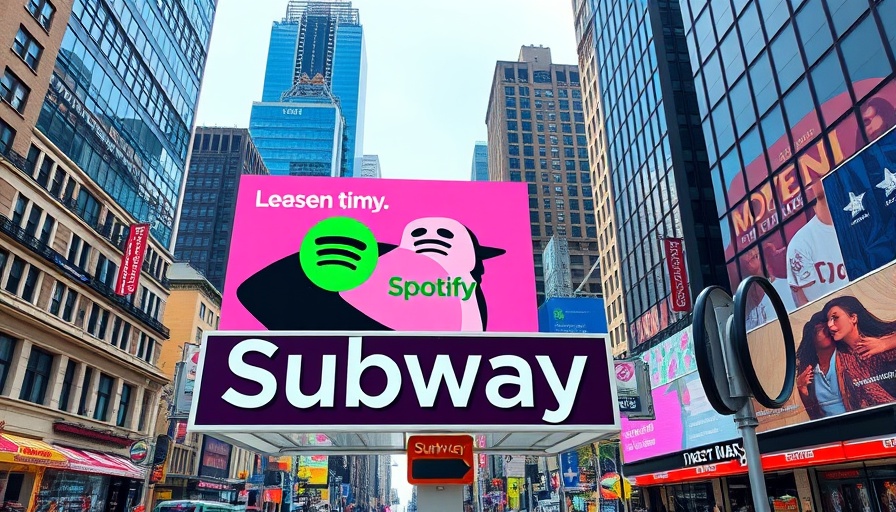
Spotify's Artistic Reimagining of Fandoms: A New Era in Marketing
Spotify has recently launched a new advertising campaign that beautifully celebrates the unique traditions and rituals of fandom. In this visually striking endeavor, the streaming platform has created a series of ads that not only showcase its artists but also honor the devoted communities surrounding them. Each ad immerses viewers into the heart of fandom culture, using vivid imagery and artistic concepts associated with the artists like Chappell Roan, Doechii, and iconic bands such as Oasis.
By wearing a pink cowboy hat, concert-goers illustrate their support for Chappell Roan, while Oasis fans can be spotted with similar haircuts akin to the famed Gallagher brothers. This effort exemplifies how fans can express their passion through unique means, establishing a distinct place for them within the cultural landscape. As Spotify continues to engage with its audience, its ads serve as a canvas for showcasing the personal connections fans have with music, making every billboard and digital post a love letter to these interactions.
The Power of Visual Storytelling in Fandom Engagement
Crafted by Spotify’s in-house creative team, this campaign marks a distinct shift from previous marketing strategies, where user data took center stage. Marc Hazan, Spotify’s VP of marketing and partnerships, notes that this new approach takes a more artistic and emotional direction, allowing for a richer connection with fans. The ads highlight specific motifs linked to artists — from ocean waves of pink cowboy hats reflecting Chappell Roan’s “Pink Pony Club” to the whimsical inclusion of albino alligators for Doechii’s album promotions.
This shift signifies a strategic choice to emphasize artistry over analytics, a surprisingly bold move from a platform known for data-driven marketing. By intertwining the visual aspects of the music experience, Spotify forges a deeper bond between artists, their identities, and the expectations of their followers. When fans see ads that resonate on such an artistic level, it not only enhances their experience but also cultivates loyalty and engagement.
Understanding the Impact of Campaigning on Fan Culture
As we reflect on how this campaign can influence small businesses, it’s important to draw upon the lessons from Spotify’s marketing strategies. Much like audiences connecting with their favorite artists, brands measured in their outreach can learn the immense value of understanding their customers’ unique passions.
Facebook and Instagram have proven to be successful platforms for passionate brands, but the emerging significance of platforms like Spotify highlights a cultural shift in how audiences engage with media. As small businesses navigate an ever-evolving digital landscape, brands that understand and resonate with the emotional investment of their audience, like Spotify does, can create immensely powerful campaigns that foster dedicated communities.
The Future of Brand Loyalty: Insights from Spotify's Campaign
As this campaign rolls out in key global markets, small businesses should watch and learn. Examining how Spotify continues to utilize art and emotion over traditional marketing techniques may offer insights into future advertising. Brands aiming to cultivate loyalty should take notes; the trend appears to be steering businesses toward emotional authenticity — a space marked by vibrant storytelling and genuine engagement. Additionally, brands can further personalize advertising strategies, mirroring the success seen with Spotify’s “Wrapped” campaign, which uses individualized data to create unique fan experiences.
Why Small Businesses Should Embrace Creative Storytelling
In embracing creative storytelling and artistic engagement, small businesses can discover their niche and form meaningful connections within their communities. This new Spotify initiative illustrates that success lies not only in the product offered but in the experiences shaped around it. Brands can empower advocates, create ambassadors from regular customers, and illustrate shared values through tailored messaging that resonates.
Final Thoughts: Join the Movement of Art and Fandom
As Spotify continues to craft its narrative through the lens of fandom, small businesses hold valuable lessons about the importance of community engagement, emotional storytelling, and the possibility of building brand love in an age dominated by analytics. By tapping into the passions of their customers, small businesses can not only survive but thrive in the competitive landscape. Start considering how your brand can create its own love letter to the passions driving your audience.
 Add Row
Add Row  Add
Add 




Write A Comment